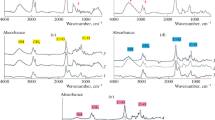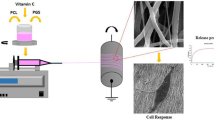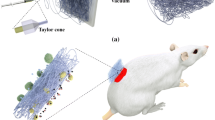Abstract
The biocompatible and biodegradable polymers of poly (glycerol sebacate) (PGS) and poly (1,8-octanediol citrate) (POC) were used to fabricate a core–shell structure, in this research. The polymers were synthesized by polycondensation, and then electrospun with the second polymer of polycaprolactone (PCL). The morphology, mechanical, and physical properties of the PGS/PCL, POC/PCL, and the core–shell structure (PGS/PCL–POC/PCL) were obtained. The in vitro degradation and the response of the retinal cells on the scaffolds were also investigated. The presence of the POC in the composition increased the fiber diameter from 409 nm in the PGS/PCL scaffold to 474, and 521 nm in the POC/PCL, and the core–shell scaffolds, respectively. A similar trend was observed in the surface pore size of the scaffolds. The porosity of the scaffolds was measured in the range of 40–60%. The transmission electron microscopy confirmed the core–shell structure of the scaffold. The chemical structure of the scaffolds was also investigated using FTIR. According to the mechanical experiments, the PGS/PCL and PGS/PCL–POC/PCL showed relatively close tensile modulus, ultimate tensile strength, and strain at break to the retina properties. The POC contained scaffolds illustrated higher hydrophilicity and degradation rate compared to the PGS/PCL scaffold. The MTS experiments demonstrated no cytotoxicity in the prepared scaffolds. The cultured cells were attached and proliferated very well on all the scaffolds, especially on the POC contained one. According to the obtained results, the PGS/PCL–POC/PCL coaxial structure was a suitable scaffold for retinal tissue engineering application.








Similar content being viewed by others
References
Anindyajati A (2019) Electrospun biomaterials and related technologies. Jurnal Teknosains 8:168
Du Y, Ge J, Shao Y, Ma PX, Chen X, Lei B (2015) Development of silica grafted poly (1, 8-octanediol-co-citrates) hybrid elastomers with highly tunable mechanical properties and biocompatibility. J Mater Chem B 3(15):2986–3000
Fatemeh J, Khorasani SN, Alihosseini F, Semnani D, Khalili S, Neisiany RE (2020) Development of an electrospun scaffold for retinal tissue engineering. Polym Sci Ser B 62(3):290–298
Guo Y, Liang K, Ji Y (2019) New degradable composite elastomers of POC/PCL fabricated via in-situ copolymerization blending strategy. Eur Polymer J 110:337–343
Hsieh W-C, Chang C-P, Lin S-M (2007) Morphology and characterization of 3D micro-porous structured chitosan scaffolds for tissue engineering. Colloids Surf B 57(2):250–255
Jeong CG, Hollister SJ (2010) A comparison of the influence of material on in vitro cartilage tissue engineering with PCL, PGS, and POC 3D scaffold architecture seeded with chondrocytes. Biomaterials 31(15):4304–4312
Jeong CG, Hollister SJ (2010) Mechanical and biochemical assessments of three-dimensional poly(1,8-octanediol-co-citrate) scaffold pore shape and permeability effects on in vitro chondrogenesis using primary chondrocytes. Tissue Eng Part A 16(12):3759–3768
Khalili S, Khorasani SN, Saadatkish N, Khoshakhlagh K (2016) Characterization of gelatin/cellulose acetate nanofibrous scaffolds: prediction and optimization by response surface methodology and artificial neural networks. Polym Sci Ser A 58(3):399–408
Khalili S, Nouri Khorasani S, Razavi M, Hashemi Beni B, Heydari F, Tamayol A (2018) Nanofibrous scaffolds with biomimetic structure. J Biomed Mater Res Part A 106(2):370–376
Lam CXF, Savalani MM, Teoh S-H, Hutmacher DW (2008) Dynamics of in vitro polymer degradation of polycaprolactone-based scaffolds: accelerated versus simulated physiological conditions. Biomed Mater (Bristol, England) 3(3):034108
Langer R (2000) Biomaterials in drug delivery and tissue engineering: one laboratory's experience. Accounts Chem Res 33(2):94–101
Lavik EB, Klassen H, Warfvinge K, Langer R, Young MJ (2005) Fabrication of degradable polymer scaffolds to direct the integration and differentiation of retinal progenitors. Biomaterials 26(16):3187–3196
Masoudi Rad M, Nouri Khorasani S, Ghasemi-Mobarakeh L, Prabhakaran MP, Foroughi MR, Kharaziha M, Saadatkish N, Ramakrishna S (2017) Fabrication and characterization of two-layered nanofibrous membrane for guided bone and tissue regeneration application. Mater Sci Eng C Mater Biol Appl 80:75–87
Masoumi N, Larson BL, Annabi N, Kharaziha M, Zamanian B, Shapero KS, Cubberley AT, Camci-Unal G, Manning KB, Mayer JE Jr, Khademhosseini A (2014) Electrospun PGS:PCL microfibers align human valvular interstitial cells and provide tunable scaffold anisotropy. Adv Healthc Mater 3(6):929–939
Masoumi N, Larson BL, Annabi N, Kharaziha M, Zamanian B, Shapero KS, Cubberley AT, Camci-Unal G, Manning K, Mayer JE (2014) Electrospun PGS: PCL microfibers align human valvular interstitial cells and provide tunable scaffold anisotropy. Adv Healthcare Mater 3(6):929–939
Nadim A, Khorasani SN, Kharaziha M, Davoodi SM (2017) Design and characterization of dexamethasone-loaded poly (glycerol sebacate)-poly caprolactone/gelatin scaffold by coaxial electro spinning for soft tissue engineering. Mater Sci Eng, C 78:47–58
Neeley WL, Redenti S, Klassen H, Tao S, Desai T, Young MJ, Langer R (2008) A microfabricated scaffold for retinal progenitor cell grafting. Biomaterials 29(4):418–426
Prabhakaran MP, Nair AS, Kai D, Ramakrishna S (2012) Electrospun composite scaffolds containing poly(octanediol-co-citrate) for cardiac tissue engineering. Biopolymers 97(7):529–538
Pritchard CD, Arnér KM, Neal RA, Neeley WL, Bojo P, Bachelder E, Ghosh FK (2010) The use of surface modified poly (glycerol-co-sebacic acid) in retinal transplantation. Biomaterials 31(8):2153–2162
Rai R, Tallawi M, Grigore A, Boccaccini A (2012) Synthesis, properties and biomedical applications of poly(glycerol sebacate) (PGS): a review. Prog Polym Sci 37:1051–1078
Redenti S, Neeley WL, Rompani S, Saigal S, Yang J, Klassen H, Langer R, Young MJ (2009) Engineering retinal progenitor cell and scrollable poly(glycerol-sebacate) composites for expansion and subretinal transplantation. Biomaterials 30(20):3405–3414
Salehi S, Bahners T, Gutmann JS, Gao SL, Mäder E, Fuchsluger TA (2014) Characterization of structural, mechanical and nano-mechanical properties of electrospun PGS/PCL fibers. RSC Adv 4(33):16951–16957
Salehi S, Fathi M, Javanmard SH, Bahners T, Gutmann JS, Ergün S, Steuhl KP, Fuchsluger TA (2014) Generation of PGS/PCL blend nanofibrous scaffolds mimicking corneal stroma structure. Macromol Mater Eng 299(4):455–469
Saud PS, Pant B, Twari AP, Ghouri Z, Park M, Kim HY (2015) Effective photocatalytic efficacy of hydrothermally synthesized silver phosphate decorated titanium dioxide nanocomposite fibers. J Colloid Interface Sci 465:225–232
Saud PS, Ghouri Z, Pant B, An T, Lee JH, Park M, Kim HY (2016) Photocatalytic degradation and antibacterial investigation of nano synthesized Ag3VO4 particles @PAN nanofibers. Carbon Letters 18:30–36
Saud PS, Pant B, Ghouri Z, Panthi G, Park SJ, Han W, Park M, Kim HY (2015) Synthesis and characterization of photocatalytic and antibacterial PAN/Ag2CO3 composite nanofibers by ion exchange method. Fibers and Polymers 16:1336–1342
Sundback CA, Shyu JY, Wang Y, Faquin WC, Langer RS, Vacanti JP, Hadlock TA (2005) Biocompatibility analysis of poly(glycerol sebacate) as a nerve guide material. Biomaterials 26(27):5454–5464
Tao S, Young C, Redenti S, Zhang Y, Klassen H, Desai T, Young MJ (2007) Survival, migration and differentiation of retinal progenitor cells transplanted on micro-machined poly(methyl methacrylate) scaffolds to the subretinal space. Lab Chip 7(6):695–701
Taylor L, Arnér K, Kolewe M, Pritchard C, Hendy G, Langer R, Ghosh F (2017) Seeing through the interface: poly (ε-Caprolactone) surface modification of poly (glycerol-co-sebacic acid) membranes in adult porcine retinal explants. J Tissue Eng Regenerative Med 11(8):349–2358
Wang Y, Kim YM, Langer R (2003) In vivo degradation characteristics of poly(glycerol sebacate). J Biomed Mater Res, Part A 66A(1):192–197
Warfvinge K, Kiilgaard JF, Lavik EB, Scherfig E, Langer R, Klassen HJ, Young MJ (2005) Retinal progenitor cell xenografts to the pig retina: morphologic integration and cytochemical differentiation. Arch Ophthalmol 123(10):1385–1393
Yang J, Webb AR, Pickerill SJ, Hageman G, Ameer GA (2006) Synthesis and evaluation of poly(diol citrate) biodegradable elastomers. Biomaterials 27(9):1889–1898
Yao J, Tao S, Young M (2011) Synthetic polymer scaffolds for stem cell transplantation in retinal tissue engineering. Polymers 3:899–914
Author information
Authors and Affiliations
Corresponding author
Additional information
Publisher's Note
Springer Nature remains neutral with regard to jurisdictional claims in published maps and institutional affiliations.
Rights and permissions
About this article
Cite this article
Fakhari, Z., Nouri Khorasani, S., Alihosseini, F. et al. Core–shell nanofibers of poly (glycerol sebacate) and poly (1,8 octanediol citrate) for retinal regeneration. Polym. Bull. 79, 7161–7176 (2022). https://doi.org/10.1007/s00289-021-03850-3
Received:
Revised:
Accepted:
Published:
Issue Date:
DOI: https://doi.org/10.1007/s00289-021-03850-3




